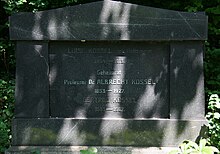Walther Kossel
Walther Kossel (born January 4, 1888 in Berlin , † May 22, 1956 in Kassel ) was a German physicist and university professor .
Life
Walther Kossel was the son of the Nobel Prize for Medicine Albrecht Kossel and his wife Luise geb. Holtzmann , the daughter of the philologist Adolf Holtzmann . Walther Kossel was married to Hedwig Olga Kossel (1888–1958).
Kossel received his doctorate in 1911 under Philipp Lenard in Heidelberg. Then he went to Munich, where he completed his habilitation at the Technical University. As a student of Arnold Sommerfeld in Munich, Kossel was professor for theoretical physics at the Christian-Albrechts-Universität Kiel from 1921 . In 1929/30 he was its rector . In 1924 he was elected a corresponding member of the Academy of Sciences in Göttingen .
In 1932 he moved to the TH Danzig ( Free City of Danzig ) as Professor of Experimental Physics and successor to Carl Ramsauer . In November 1933 he signed the professors' declaration of Adolf Hitler at German universities and colleges . In 1940 he was elected a member of the Leopoldina .
In 1945 he followed the call of the Eberhard-Karls-Universität Tübingen to the chair for theoretical physics. In 1953 he retired .
Works
Kossel's field of work was mainly the research of the atomic structure and the structure of the molecules . In 1914 he developed a theory of the absorption and emission of X-rays. In 1916, based on the then new quantum hypothesis of Niels Bohr, he set up a working hypothesis on the theory of covalent bonds ( valence theory ). He researched the electromagnetic spectra of X-ray and gamma radiation and, in Kiel, turned to the application of X-rays to the research of crystals and their growth. In 1928 he founded the theory of crystal growth ( Kossel-Stranski theory ). In Danzig he was able to work with better experimental equipment and from 1935 he succeeded in examining crystals with X-rays generated in them instead of with radiation from an X-ray tube. In 1935 Walter Kossel discovered the Kossel effect named after him , the interference phenomena of monochromatic X-rays emanating from atoms in a crystal . The Kossel-Sommerfeld displacement theorem also bears his name. He also investigated crystal growth experimentally, whereby he achieved independence from the initial conditions by looking at spherically ground single crystals, developed electron microscopes and dealt with diffraction theory and the electrostatic generation of high voltages.
Grave site in Heidelberg

Died in Kassel, Kossel was transferred to Heidelberg. He rests in the Heidelberg Bergfriedhof in the grave of honor of his father Albrecht Kossel . His wife and other family members were also buried in the family grave. Walter Kossel's life dates are carved on a granite stone.
Awards
- Max Planck Medal 1944
- University medal from the University of Kiel 1948
- 1955 honorary member of the German Physical Society
- X-ray plaque of the city of Remscheid (1956)
Eminent students
- Gerhard Borrmann
- Alfred Eckardt
- Christian Gerthsen
- Hans Hellmann
- Gottfried Möllenstedt
- Max Steenbeck
Fonts
- Valence forces and X-ray spectra , 1921
literature
- Gottfried Möllenstedt : Kossel, Walther. In: New German Biography (NDB). Volume 12, Duncker & Humblot, Berlin 1980, ISBN 3-428-00193-1 , p. 616 f. ( Digitized version ).
- Albrecht Unsöld : Obituary. In: Die Naturwissenschaften , 44, 1957, pp. 293-294
- Gottfried Möllenstedt: Obituary. In: Physikalische Blätter , 12, 1956, pp. 412-414, doi: 10.1002 / phbl.19560120905
- E. Buchwald: Walter Kossel 60 years . In: Physikalische Blätter , 4, 1948, p. 29, doi: 10.1002 / phbl.19480040108
Web links
- Literature by and about Walther Kossel in the catalog of the German National Library
Individual evidence
- ↑ Rector's speech (HKM)
- ↑ Holger Krahnke: The members of the Academy of Sciences in Göttingen 1751-2001 (= Treatises of the Academy of Sciences in Göttingen, Philological-Historical Class. Volume 3, Vol. 246 = Treatises of the Academy of Sciences in Göttingen, Mathematical-Physical Class. Episode 3, vol. 50). Vandenhoeck & Ruprecht, Göttingen 2001, ISBN 3-525-82516-1 , p. 138.
- ↑ Confession - Internet Archive p. 132
| personal data | |
|---|---|
| SURNAME | Kossel, Walther |
| ALTERNATIVE NAMES | Kossel, Walter |
| BRIEF DESCRIPTION | German physicist and university professor |
| DATE OF BIRTH | January 4, 1888 |
| PLACE OF BIRTH | Berlin |
| DATE OF DEATH | May 22, 1956 |
| Place of death | kassel |

